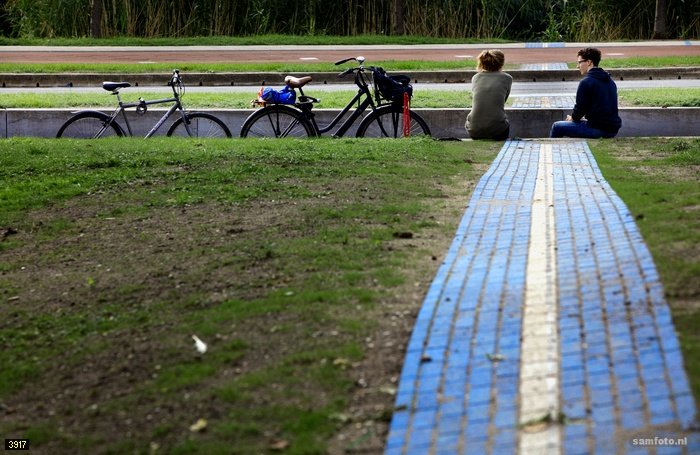The blue line
Since September a blue line is running across campus. Why?
If you travel far enough north, sooner or later, you will reach the polar circle. A sign sometimes announces your arrival, like in the Finnish city of Rovaniemi. Everyone has heard of other imaginary lines like the equator and the tropics, but now there is also one running straight across campus: the 52nd degree of latitude. When Professor Ramon Hanssen realised this years ago, he came up with the idea of making it visible. After all, results in his professional field of geodesy – which, for Hanssen, involves plenty of earth observation – are often not tangible. Therefore, in November 2011, he furtively sprayed the line on the pavement.
The funny thing about the degree of latitude, says Hanssen, is that it has a time effect. This is because the Eurasian continent is moving towards the northeast. ‘So you see the line ‘drop’. The line used to be elsewhere, which means we can make the factor of ‘time’ visible on campus. Calculations have revealed that the continent moves 16 millimetres northwards every year.’
Hanssen’s plan remained dormant for a while, until now – seven years, or 11.2 cm later – the line is a fact. It runs between the glass main building of the Faculty of Civil Engineering and Geosciences and ME.
At the centre of the blue line is a white band containing a 16-millimetre-wide black line, which indicates the position of the 52nd degree of latitude on 1 January 2018. For anyone thinking of measuring it: it is already no longer in the same position. ‘The width of the black line represents the shift per year’, explains Hanssen.
To illustrate the time effect, six grey lines have been painted parallel to the blue line. These grey lines indicate significant events related to Delft events.
- The first line is 2.79 metres to the north, and marks the foundation of TU Delft in 1842. The following three lines represent events in the Golden Age:
- The first time that Delft researcher Antoni van Leeuwenhoek described bacteria, in 1676. This line is 5.4 metres to the north of the 2018 position.
- The escape of Delft-born Hugo Grotius from Loevestein Castle in a book chest in 1621. This line is 6.3 metres more northerly than the 2018 line.
- The murder of Willem of Orange in Delft in 1584; 6.9 metres to the north of the 2018 line.
- The fifth line is 12 metres from the blue line: this was the position of the 52nd degree of latitude in 1246, when Delft was enfranchised.
- The final line, at a distance of 32 metres, indicates the start of the Western calendar era: the year 1.
‘The idea is that if you now start studying here and complete your course within the nominal study period – so, a three-year Bachelor’s and two-year Master’s – the line will have moved 5 x 16 millimetres = 8 centimetres’, says Hanssen.
Watch the video
